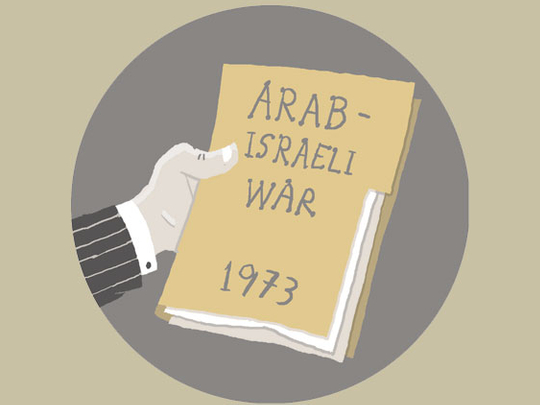
The October 1973 Arab-Israeli war was recently in the news. Last October, the most famous Egyptian spy Ahmad Al Hawan died. For over 10 years, Al Hawan achieved for Egyptian intelligence against their Israeli rivals the kind of victory that legends are made of and paved the way for the honourable Egyptian military performance in the October 1973 war.
He was a superb double agent who fooled the redoubtable Israeli Mossad into believing he was working for them. He fed them false information that played a role in preserving the surprise effect so essential for the Egyptian war strategy. He also secured for Egyptian intelligence a highly advanced technological transmitter which only two countries in the world possessed: The United States and Israel.
Last week, the Israeli press reported, citing recently published documents from the Nixon administration, heretofor unpublished details about the 1973 Arab-Israeli war.
A few days before the war broke out then Soviet foreign minister Andrei Gromyko and Soviet ambassador to Washington Anatoly Dobrynin were received at the White House by then president Richard M. Nixon and his newly appointed secretary of state, Henry Kissinger.
The discussion turned to the Middle East. Gromyko stated that both the American and the Soviets agree that the situation is dangerous, but disagree on the level of danger: “We feel the possibility could not be excluded,” he warned, “ that we could all wake up one day and find that there is a real conflagration in that area. That has to be kept in mind. Is it worth the risk?” Nixon and Kissinger ignored the warning and did nothing to prevent the breakout of hostilities.
Helmut Sonnenfeldt, who worked for the Nixon National Security Council and was present at the meeting expressed the view that a compromise in the Arab-Israeli conflict was not possible. “No matter how much in pain, the Israelis will probably use an atomic bomb before they concede the 1967 borders,” he observed.
Kissinger, adding arrogance to complacency, later claimed that on the morning of October 6, 1973 as the Egyptian army was crossing the Suez Canal, a colleague had told him that some kind of crisis between Egypt and Israel had erupted. The unnamed colleague reportedly quickly reassured Kissinger that it was nothing that he could not solve in two hours.
As the Egyptian and Syrian armies pushed the occupying Israeli forces back, the Israelis, in despair, responded with reckless escalation. Moscow sent a stern note to Washington dated October 12: “The Soviet leaders consider it necessary to bring in the most urgent way the attention of the president to the defiant, to put it straight, gangster-type actions of Israel,” the Soviet leaders stated. “The matter is, first of all, about the barbaric bombings by the Israeli aviation of peaceful population centres in Syria and Egypt, including Damascus.”
In a reference to the Scud missiles Moscow had delivered to Egypt, the Soviet leaders had threatened: “We... want the president also to know it, that the other side has a capability to deliver retaliatory strikes against Israeli cities... if the bombings of the Arab cities by Israel are not immediately stopped.”
Last year, declassified Israeli archive documents revealed for the first time that six hours before the outbreak of the war, then prime minister Golda Meir’s cabinet secretly met with the Israeli army chief of staff David Elazar and chief of military intelligence Eli Zeira. Elazar informs the cabinet that the Egyptian spy Ashraf Marawan, who did work for the Israelis, had relayed a message to the Israelis about the imminent war.
This was not the first warning the Israelis had been tipped off. King Hussain of Jordan, it is claimed, at a secret meeting with Meir on September 25, 1973 warned the Israeli leader about the coming war.
However, Mordechai Gazit, adviser to Meir, claims that “the warning Golda received was limited, because it dealt exclusively with the Syrian front.”
At the same Israeli cabinet meeting, Elazar said the pre-emptive strike would give Israel ‘huge advantage and save many lives,’ but Meir rejected the idea saying: ‘It’s tempting, but world will portray us as the aggressors.’
The Egyptian army crossed the Suez Canal and demolished the myth of the insurmountable Bar-Lev line and the myth of the invincibility of the Israeli army. The Syrian forces also pushed back the Israeli forces that were occupying the Golan Heights. For a few critical days it seemed that the very existence of Israel was at stake. Then Egyptian president Anwar Sadat presented Washington with the same demands for a peaceful settlement he had presented before the war. Kissinger ignored him. Meir and Moshe Dayan pleaded with Washington for immediate support.
Meir convened the Cabinet and with her ministers discussed the nuclear option. Dayan reportedly said, referring to Israel, “This is the end of the Third Temple.” Meir decided to order the Israeli Jericho missiles and special weapons capable F-4 “Kurnas” to be placed on alert and warheads released.
The Israelis leaked this dangerous escalation to their American benefactors. Nixon understood what was at stake and ordered Kissinger to urgently provide Israel with the weapons they needed.
“Operation Nickel Grass” went into action on October 14, 1973. US airforce planes carrying ammunition, tanks and replacement F-4s “were taken straight from USN and USAF squadrons and flown by the US crews to Sigonella Sicily, where US airmen repainted them... and turned them over to Israeli pilots.”
The online US Airforce magazine observed: “It was justifiably called “the airlift that saved Israel.”
Adel Safty is Distinguished Visiting Professor and Special Adviser to the Rector at the Siberian Academy of Public Administration, Russia. His book, Might Over Right, is endorsed by Noam Chomsky, and published in England by Garnet, 2009.










